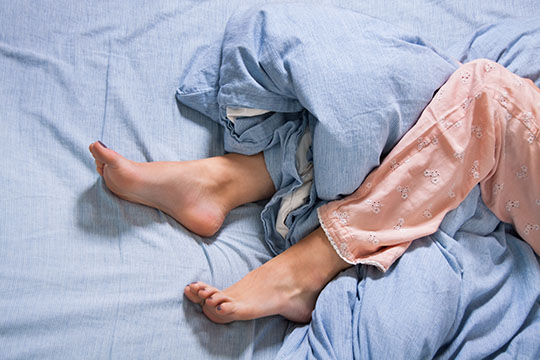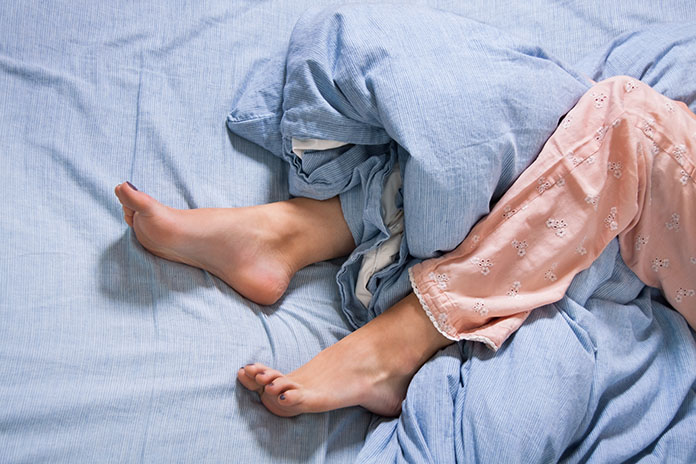
After a long day, there’s nothing better than to crawl into bed, drift off to sleep, and not stir until tomorrow morning. If you have Restless Leg Syndrome however, the scenario is a little different. You’re tired and ready to call it a night. You get comfortable in bed hoping for a good night’s sleep, but just as you’re relaxed enough to drop off, your legs seem to come alive. They twitch and bounce, feel antsy, are uncomfortable, and want to jump. You may feel like sleeping, but your legs have an entirely different idea.
Restless Leg Syndrome (RLS) is a neurological disorder that affects about ten percent of the population. It’s characterized by uncomfortable sensations in your legs with an urge to move them when you’re sitting, lying, or at rest. Symptoms may come and go and are worse at night, also making it a sleep disorder.
Restless Leg Syndrome occurs most frequently in middle aged and older people, and is more common in women than men. It can also affect pregnant women, especially during their third trimester, but in most cases symptoms disappear after delivery.
There is no test for RLS, so a diagnosis is based on presenting symptoms. In addition, there is no known cause of this condition, but doctors suspect that there is a genetic connection. Almost one-half of people who struggle with RLS have a family member who has also had it. What doctors do know is that there are risk factors for RLS, which include having a chronic illness, such as Parkinson’s, diabetes, or peripheral neuropathy. In addition, some health care providers believe that RLS may be related to a deficiency of iron, Vitamin B12, or folate. Medications, such as those to treat nausea, antidepressants, cold and allergy medications, and antihistamines have also come under scrutiny in causing RLS. And in a recent study, researchers documented that when study participant’s varicose veins were treated, 98 percent of them found relief from their RLS symptoms.
In Chinese medicine, Restless Leg Syndrome is associated with poor circulation. The symptoms are worse when you are sitting or lying down, times when your legs aren’t moving and your circulation has slowed. As indicated by the study of patients with varicose veins, when circulation is restored by treating the varicosities, symptoms of RLS subside. Therefore acupuncture and Chinese medicine can offer an effective treatment for RLS, as it enhances circulation not only locally, but throughout your body. In addition, acupuncture is an effective treatment for insomnia. If you choose to treat your RLS, your practitioner of acupuncture and Chinese medicine would likely combine acupuncture with an herbal formula to enhance their treatment, as well as dietary guidelines, bodywork, and some lifestyle tweaks to enhance your sleep.
There are also some things you can try at home if you’re struggling with RLS, including:
- Take a good food-based vitamin and mineral supplement if you don’t already. Doing so rules out a vitamin deficiency as the cause of your RLS. Because an iron deficiency may be the culprit in some cases of RLS, and iron can be toxic if you supplement it when you don’t need it, ask your doctor to check your iron levels before taking an iron supplement
- Avoid eating a large meal late in the day. If you go to bed full, your body is actively digesting, which can keep your body active and interrupt your sleep.
- Try cutting out alcohol, which can disrupt your sleep, especially later in the night. In addition, give eliminating caffeine a try, which can also mess with your sleep.
- Get some gentle exercise before bedtime, like a short walk, gentle stretching, or massaging your legs. Some people with RLS find relief from some light activity before turning in for the night.
- Make sure you’re getting enough exercise, but not too much. Some people find that when they’re physically active during the day, their RLS symptoms are better at night, however too much exercise can activate your muscles and aggravate your symptoms.
- While RLS disturbs your sleep, it’s important to get plenty of rest. Many people with Restless Leg Syndrome find that their symptoms are worse when they’re fatigued
- Experiment with temperature changes. A number of RLS sufferers have found that when they warm up their legs with a heating pad, their symptoms are greatly reduced. Applying heat actually relaxes your muscles and increases the circulation in your legs. On the flip side, other people have found that soaking their legs in cool water before bedtime has been helpful. The cool temperature initially constricts your blood vessels, but gently opens them up and increases circulation when you get into a warm bed.
- If you’re under a lot of stress, do what it takes to deal with it. Stress interrupts your sleep with or without restless legs, and stress aggravates any health conditions you may have. Bringing calm into your life can only help.
- Some people with RLS report that their legs act up only in certain positions. When your leg symptoms begin, try switching up positions.
- Finally, keep track of what things aggravate your symptoms and what things help them calm down for some clues to triggers and ways to manage your symptoms. Also remember that it may be a combination of factors that makes a difference.

Cindy Chamberlain is an acupuncturist in Overland Park, KS and the founder of Eastern Healing Solutions, LLC. She is licensed in Kansas and Missouri and has been practicing traditional Chinese medicine since 1996.


